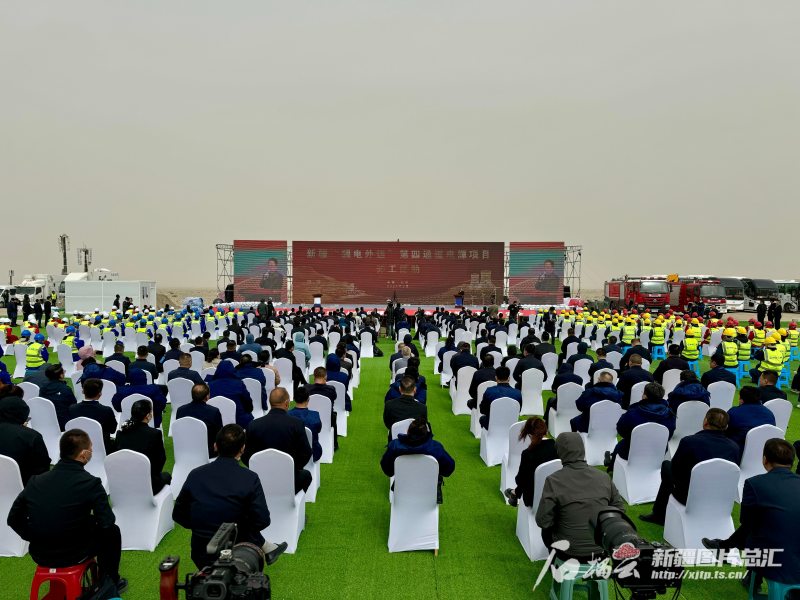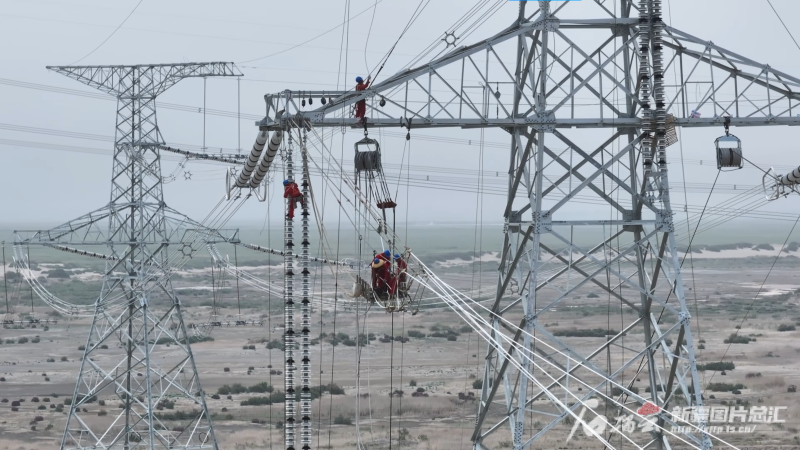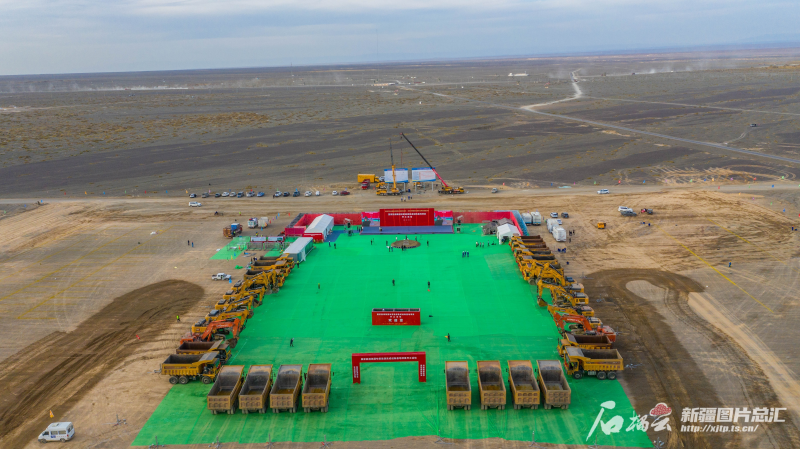Shiliuyun-Xinjiang Daily (Reporter Shi Xin) news: As one of the "three engines" driving economic growth, investment serves as a pivotal variable linking both the supply and demand sides, and is a supportive and leading indicator for stabilizing economic growth. In the first three quarters of this year, total fixed asset investment in China's Xinjiang increased by 6.2 percent year-on-year, outpacing the national growth rate by 2.8 percentage points.
Looking at the structure through the data, it is not difficult to find that the scale of fixed asset investment in China's Xinjiang has continued to expand, with strong momentum in key areas, and the foundation for stability has been continuously consolidated, providing solid support for high-quality economic development.
The supporting role of major projects is prominent
Entering the fourth quarter, China's Xinjiang has reached a crucial point for completing the annual tasks. With each autumn rain bringing colder weather, the enthusiasm for development continues to rise despite the gradually dropping temperatures.
In Ruoqiang County, Bayingolin Mongolian Autonomous Prefecture, the construction of the fourth transmission channel power supply project for "transmitting Xinjiang's electricity to other provinces and regions" is being accelerated. This is the first major project with an investment scale of over RMB 100 billion (about 13.8 billion U.S. dollars) in Xinjiang this year. From being included in the national plan to the approval of the supporting power supply scheme, it only took 266 days, setting a national record for the fastest approval of a large-scale base in desert, Gobi, and barren land and its supporting power supply scheme.

Photo taken on September 28, 2024 shows the opening ceremony of the construction of the fourth transmission channel power supply project for "transmitting Xinjiang's electricity to other provinces and regions" in northwest China's Xinjiang Uygur Autonomous Region. (Photo by Shiliuyun-Xinjiang Daily/Shi Xin)
Major projects are the ballast stones for stabilizing economic growth and the hard support for promoting high-quality development. Especially since the third quarter, China's Xinjiang has witnessed a continuous influx of new and promising projects, bringing a steady stream of economic vitality.
On October 9, 2024, Turpan City held the groundbreaking ceremony for major projects in the fourth quarter of 2024 and the preparatory phase of the Xinjiang Huadian Shanshan Pumped Storage Power Station Project. A total of 17 major projects were launched with a total investment of RMB 66.42 billion (about 9.17 billion U.S. dollars), covering industries such as renewable energy, coal and coal chemicals, and silicon-based new materials.
On October 24, 2024, the 40th elite project exchange and matching event of the Ministry of Culture and Tourism's industrial project service platform and the investment and financing promotion event for Xinjiang's cultural and tourism industries were held in Horgos City, Ili Kazak Autonomous Prefecture, northwest China's Xinjiang Uygur Autonomous Region. Contracts were signed for a total amount exceeding RMB 11 billion (about 1.52 billion U.S. dollars), and a number of cultural and tourism projects, including the Alimali Project in Guozigou, Huocheng County, and the "National Highway, Red Border - China's Most Beautiful Border Route G219" cultural and tourism project, will be implemented in China's Xinjiang.
"In terms of investment projects, newly started projects and large-scale projects have provided strong support," said Hao Junqing, member of the leading Party members group of the Xinjiang Uygur Autonomous Region Bureau of Statistics and the deputy director of the Xinjiang Uygur Autonomous Region Bureau of Statistics. He believes that this is the primary characteristic of fixed asset investment in Xinjiang in the first three quarters.

Photo taken on August 28, 2024 shows electrical workers connect the conductors on the iron towers at the construction site of the Bazhou-Tieganlike-Ruoqiang 750kV Ultra-High Voltage Power Transmission and Transformation Project in northwest China's Xinjiang Uygur Autonomous Region. (Photo by Shen Kailong)
Statistical data shows that in the first three quarters, Xinjiang had 1,542 newly included projects, with an average project scale increase of 56.7 percent. The investment completed by these newly included projects increased by 26.8 percent year-on-year, with the growth rate increasing by 3.1 and 36.5 percentage points compared to the first half of the year and January to August, respectively. Projects under construction with a planned total investment of RMB 1 billion (about 138 million U.S. dollars) or more accounted for 46.4 percent of fixed asset investment, up 19.8 percent year-on-year, driving an 8.2-percentage-point increase in fixed asset investment.
The growth in newly included projects indicates strong momentum for high-quality development, while the orderly progress of ongoing projects provides a guarantee for early momentum from new drivers. These are the sources of confidence for China's Xinjiang to stabilize economic growth.
Investment in industries boosting the growth
On September 9, 2024, the foundation laying ceremony for the key project of Hami City, the Hami Oil-rich Coal Science and Innovation Park, was held in the Yiwu Industrial Park in Hami City, northwest China's Xinjiang Uygur Autonomous Region. This project aims to deeply explore the potential value of oil-rich coal, promote its scientific development and efficient utilization, and inject strong momentum into the green transformation and sustainable development of the coal industry in China's Xinjiang.
At the same time, Xinjiang's major industrial project with an investment scale of over RMB 100 billion (about 13.81 billion U.S. dollars), the Hami-Chongqing ±800 kV UHV DC Transmission Project, is also being accelerated in accordance with the annual objectives. Currently, the construction site of the project (Xinjiang section) has completed the excavation of tower foundation pits and foundation pouring, and is now proceeding with the assembly of iron towers. The supporting power supply project, the Xinjiang Huadian Tianshan Green Energy 2×1,000 MW Coal-Fired Power Project, is also under intensive construction, with plans to complete the hydrostatic test of the first boiler and the closure of the main powerhouse by the end of this year.
Currently, focusing on the construction of the nine major industrial clusters, Xinjiang is fully promoting the implementation of a series of major industrial projects.
Statistical data shows that in the first three quarters, industrial investment increased by 20.3 percent year-on-year, with its share of fixed asset investment rising from 46.4 percent in the same period last year to 52.5 percent, driving a 9.4-percentage-point increase in fixed asset investment.
Industrial investment not only stimulates sustained growth in fixed asset investment but also plays a crucial role in promoting stable and positive development in the industrial economy and driving economic growth.
Notably, the first intelligent computing center in Xinjiang, the China Mobile (Karamay) Cloud Computing and Intelligent Computing Center, has been opened in the Karamay Cloud Computing Industrial Park in Karamay City, northwest China's Xinjiang Uygur Autonomous Region. Additionally, China's first 10,000-meter scientific exploration well was drilled in Xinjiang, and the region has achieved the world's first dual-gas co-production globally.

Photo shows a glimpse of the Karamay Cloud Computing Industrial Park in Karamay City, northwest China's Xinjiang Uygur Autonomous Region. (Photo by Cui Wenjuan)
Since the beginning of this year, the construction of a number of high-tech manufacturing projects has accelerated, contributing to the high-quality development of investment. Correspondingly, in the first three quarters, high-tech manufacturing investment in China's Xinjiang increased by 39.9 percent year on year.
In addition, Xinjiang is promoting the high-quality development of key industrial chains by accelerating the extension, completion, and strengthening of characteristic and advantageous industries, such as oil and gas, coal, and minerals, further optimizing the investment structure.
Industrial technology renovation investment serves as an example. In the first three quarters, industrial technology renovation investment in China’s Xinjiang increased by 12.3 percent year on year.
"The rapid growth of technology renovation investment has provided strong support for the transformation and upgrading of traditional industries. The industrial economy of Xinjiang is moving towards new quality improvements, with emerging industries such as new energy batteries and new materials accelerating their development," said Hao Junqing.
Seize the opportunity for the fourth quarter
On October 8, 2024, the first day after the National Day holiday, the project of the Hami Energy Integration Innovation Base of the CHN Energy Investment Group commenced, sending a strong signal that Xinjiang is putting action first and going all out to accomplish its annual goals and tasks.

Photo taken on October 7, 2024 shows the day before the date of commence of the construction project of the Hami Energy Integration Innovation Base of the CHN Energy Investment Group in northwest China's Xinjiang Uygur Autonomous Region. (Photo by Shiliuyun-Xinjiang Daily/Shi Xin)
This is the second major project with an investment of over RMB 100 billion (about 13.81 billion U.S. dollars) to commence in China's Xinjiang this year. With a total investment of RMB 170 billion yuan (about 23.47 billion U.S. dollars), the project leverages the advantages of Hami's oil-rich coal and wind-solar resources to establish a national strategic base for coal-to-oil and coal-to-gas conversion.
"Overall, this year's investment in China's Xinjiang is expected to follow a trend of high in the beginning, low in the middle, and stable towards the end," said Zhang Yongliang, director of the Fixed Asset Investment Division of Development and Reform Commission of Xinjiang Uygur Autonomous Region. In the first quarter, Xinjiang achieved a strong start with high investment growth. The second and third quarters saw low-speed fluctuations. However, with the commencement of major projects worth over RMB 100 billion yuan, such as the fourth transmission channel for "transmitting Xinjiang's electricity to other provinces and regions" and the Hami Energy Integration Innovation Base, as well as the accelerated implementation of a new batch of renewable energy projects and the accelerated implementation of special local government bond projects issued in September this year, it is expected that investment in Xinjiang will stabilize and rebound in the fourth quarter.
It is fighting hard in the fourth quarter to wrap up the year with a strong finish.
With the annual investment targets in mind, the Development and Reform Commission of Xinjiang Uygur Autonomous Region will break down the fourth-quarter investment tasks into monthly objectives for each project, implementing a list-based management approach, and advancing the projects according to key milestones.
Meanwhile, the progress of major projects will be closely monitored, with a focus on the construction of projects in key areas such as water conservancy, transportation, housing and urban-rural development, power grids, and renewable energy. Special attention will be given to the construction of 29 highway projects, including the G219 Zhaosu-Wensu section, as well as the acceleration of railway projects such as the Golmud-Korla Railway, Jiangjunmiao-Naomaohu Railway, and Lop Nur-Ruoqiang Railway. Efforts will also be intensified to expand the construction of the Urumqi Airport expansion project. Additionally, the implementation of newly planned wind and photovoltaic projects will be accelerated.
Funding security is the foundation for expanding effective investment. Xinjiang will also expedite the payment of government investment funds, prioritizing the disbursement of the additional treasury bonds issued in 2023, accelerating the expenditure of ultra-long-term treasury bonds and special debt funds, and increasing the payment of centrally budgeted funds.
Starting from the vibrant spring and extending to the snowy winter, China's Xinjiang remains committed to advancing projects, expanding investment, and boosting economic momentum.
(A written permission shall be obtained for reprinting, excerpting, copying and mirroring of the contents published on this website. Unauthorized aforementioned act shall be deemed an infringement, of which the actor shall be held accountable under the law.)









